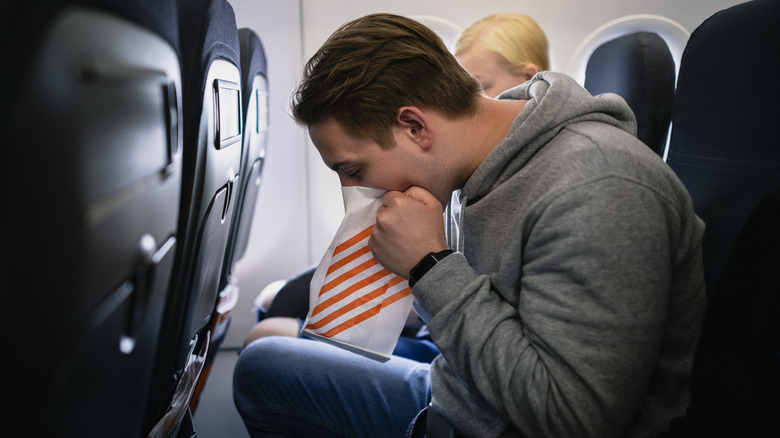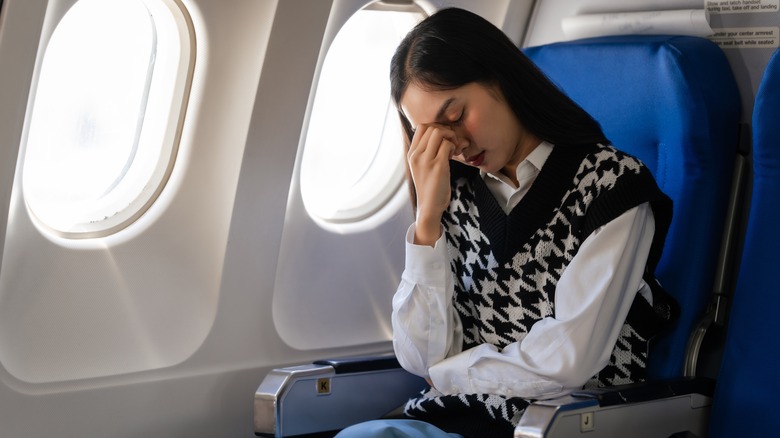Why Airlines No Longer Carry Barf Bags
If you've ever flown before, you know that you can find your airline's safety manual and inflight meal information in your seatback pocket (which also happens to be the dirtiest spot in your airplane seat). And if you're lucky, you might find a barf bag. Created in 1949 by inventor Gilmore T. Schjeldahl, they were once an airline essential. Schjeldahl's innovation was revolutionary because he lined the bag with plastic, which prevented leaks. Schjeldahl's barf bag, however, was designed not for the purpose it's used now but for keeping food fresh.
Air sickness has been around since commercial flying was introduced in the 1920s. Before Schjeldahl's barf bag came along, Slate states that airlines used everything from paper bags to bowls or cups for those who suffered from this malady. If you're unfamiliar with air sickness, this is essentially the same as motion sickness. Symptoms include headache, dizziness, loss of appetite, and nausea, amongst other unpleasantries.
Besides their most obvious use, barf bags were, at one point, utilized by Spirit Airlines for advertising purposes. Nevertheless, barf bags have become a rarity in the past few years. But why? It appears that it all comes down to technology and money.
Airsickness is not as common on planes anymore
When commercial flying began, it was an experience, to say the least. Simply put, it was rudimentary, leading passengers to experience air sickness readily. According to Vox, a lack of pressurized aircraft cabins and dizzying smells (like gasoline) caused this. Thus, barf bags were provided for passengers just in case the smells and the absence of fresh air got to them. In addition, there was terrible turbulence, creating a disastrous formula. However, alterations to commercial flying have made these factors problems of the past.
Without pressurized cabins, planes had to fly at low altitudes. Lower altitudes mean more turbulence and air sickness. In the 1950s, pressurized cabins became the norm, allowing airplanes to fly at much higher altitudes than they were before. This, in turn, lessened turbulence and air sickness. Likewise, there's less fear when flying (apprehension could also account for air sickness).
This is all to say that passengers nowadays don't get as sick as often, and experts note that barf bags are not a necessity but rather a reassurance provided by airlines to passengers. It's for these reasons that some airlines, like Spirit Airlines, have stopped carrying barf bags altogether. If people don't need them, why have them? Ultimately, getting rid of barf bags is a financial decision, as not supplying them is more cost-effective.
Bring your own barf bag
While it's unclear what airlines besides Spirit have officially done away with barf bags, you could contact your airline to find out. But if you're susceptible to air sickness and are flying soon, pack a barf bag just in case. They can easily be purchased online in a variety of colors and designs. However, there are also tips for avoiding motion sickness on a plane.
They include taking Dramamine before your flight and drinking ginger ale to settle your stomach. In addition, choosing a seat toward the front of the plane will lessen your exposure to turbulence. If you start feeling sick and can't find a barf bag in your seatback pocket or didn't bring your own, press the flight attendant call button. Ask if they have a spare bag, but if the situation is dire, don't wait; head to the bathroom to avoid any accidents.
Having said all that, a report published by Data Intelo states that the barf bag industry was expected to have a compound annual growth rate (CAGR) of 5.5% from 2022 to 2030. In other words, barf bags are making a global comeback. The report notes that this directly results from hygiene practices stemming from the COVID-19 Pandemic.


